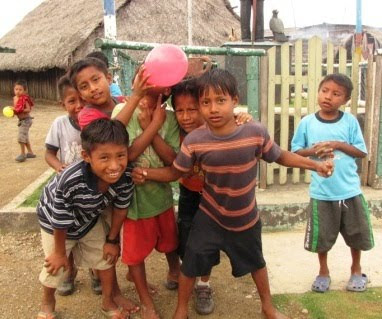Kuna village with lush mainland hills layered behind. We had to wait a week until the clouds lifted to get a sunny picture - it was the end of the 5 month rainy season.

Kuna father and son heading home from the fishing grounds.
A typical San Blas island. There are many hundreds like this along the hundred km coastline. The Kunas tend the palms and harvest the coconuts. Every tree belongs to a village.
Kuna village waterfront. The outhouse on the right just hangs out over the water. The reed and thatch houses are densely packed, with only narrow paths between them. The islands are very low, with typical elevations of only 2-3'. Storm surge and rising sea levels make fighting erosion a constant job.
The kids are alright! Kuna kids were very friendly and would run up and take our hands to lead us through their villages. In contrast to the adults, they loved to have their pictures taken. Behind them is a dugout canoe or ulu, nearing completion. Takes a long time with only hand tools.
These guys were up for a game of balloon volleyball - and anything else!

Molas are the traditional front and back panels which decorate the blouses of Kuna women and have become a renowned form of folk art. They consist of intricate, often geometric designs, created from multiple cut-through layers of fabric and extremely fine embroidery. One mola can take more than a month to complete. She was one of only two woman willing to have her picture taken (in the six weeks we there!) and she crouched over so far that her mola can't be seen, though her nose ring can.
Little girl and her grandmother wearing molas and navy wrap skirts. The grandmother is also wearing the traditional beaded leggings and bracelets. She allowed us to take her picture because we bought two of her molas.

Master mola maker, Venancio. It was difficult to choose from amongst his dozens of fine works. So we bought several - actually, more than several....
A more modern design with the upper part of the blouse cut away after we bought it. The bits would be reused.

We should get sails like that!






